The names variegated leaf and variegated root come straight to the point: Caladium is a lush ornamental plant with variegated and patterned foliage.

However, it does not come as a monochromatic plant because it Caladium has many versions in a variety of colors. Here you can find out how to plant and care for this decorative tuberous plant.
Caladium: flower, origin and characteristics
Caladium is a genus of plants in the family Arum (Araceae), which includes 14 species. The Caladium species are native to Central and South America, where they grow in tropical areas. The potted plants that are known in our country are usually hybrids bred from different species. These are also called elephant ears, variegated leaves or variegated roots and are popular mainly because of their colorful and patterned leaves. These are heart- or arrow-shaped and can be green, red, pink or silver-colored, mottled or simple. The leaves become up to 20 cm high and thus sometimes become so heavy that the long leaf stalks break off. The thin stems rise directly from an underground tuber. This tubercle acts as a survival organ. In winter, all the leaves die and only the tuber overwinters, so that next year it can grow leaves again. The perennial herbaceous plant usually grows about 60 cm tall. In nature, caladium forms a copper flower, which is surrounded by bracts. It is quite inconspicuous and unspectacular compared to the patterned leaves. Caladium potted plants do not usually bloom at all.
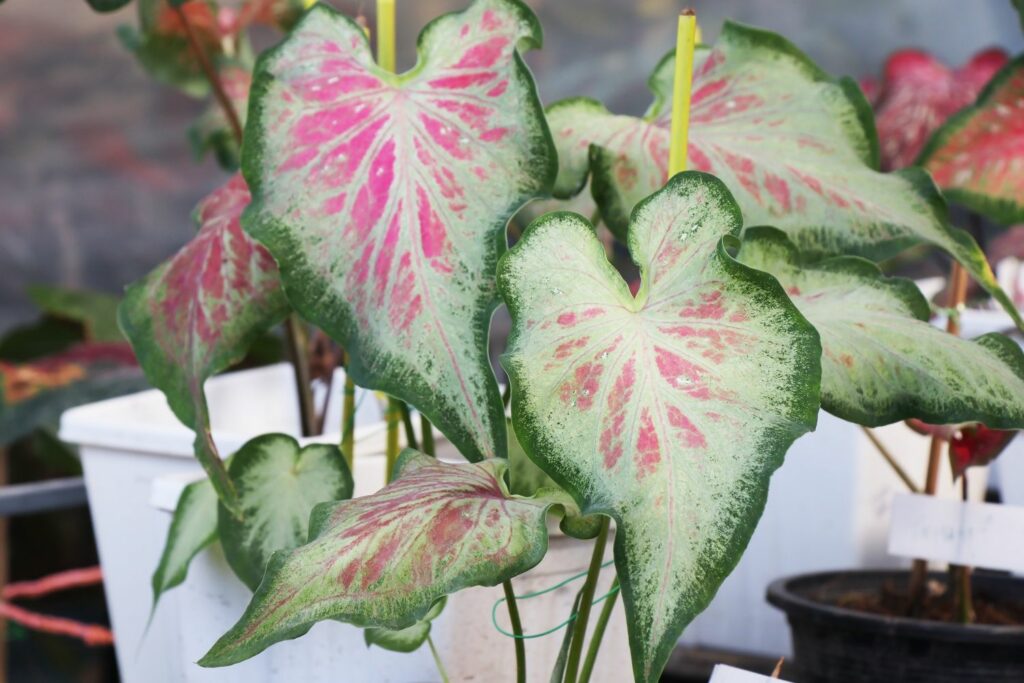
The most beautiful colored species and varieties
Countless Caladium varieties are now commercially available, differing in color and pattern. Originally, Caladium bicolor was mainly used for cultivation, but now a lot of other species have been incorporated. For this reason, the species name is not usually mentioned at all. We have compiled a small selection of exciting varieties for you:
- Caladium “The White Queen”: has whitish leaves with green edges, with midrib and some main veins in light pink.
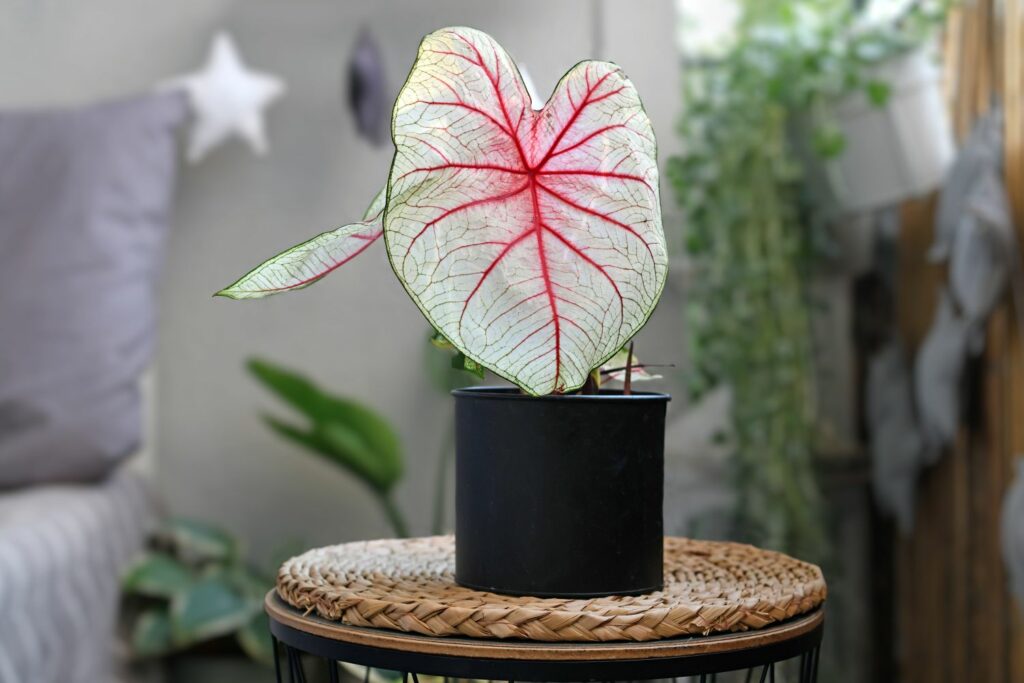
- Caladium “Strawberry Star”: has white leaves with green veins and small pink dots.

- Caladium “Miss Muffet”: with light green leaves decorated with pink dots.

- Caladium “Pink Symphony”: has bright pink leaves with green veins.
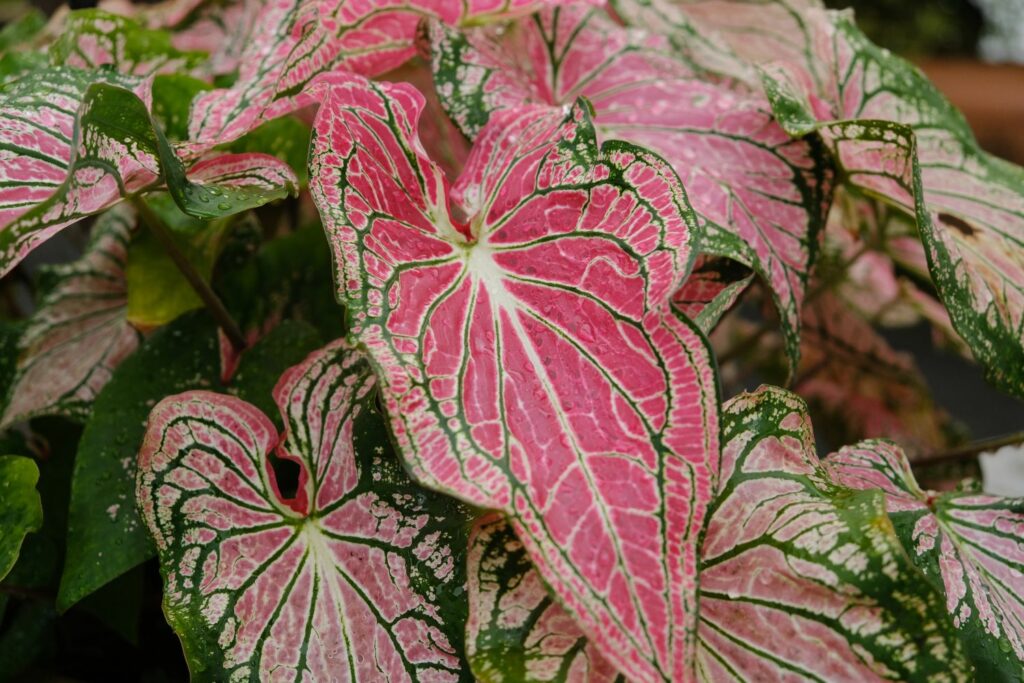
- Caladium “Valentina”: has red leaves with dark green veins.
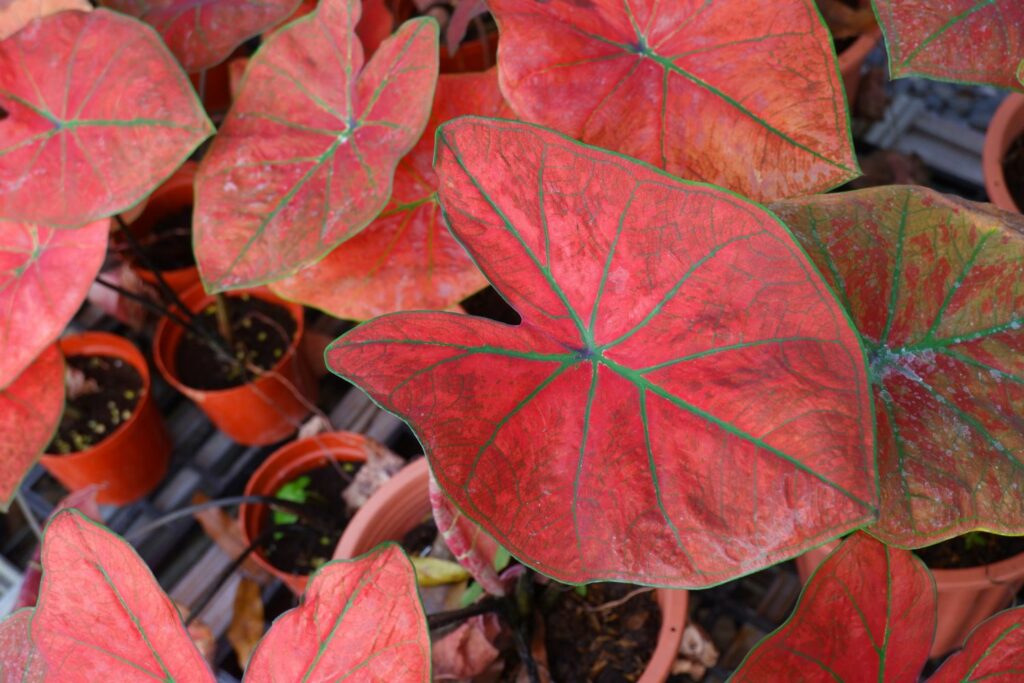
- Caladium ‘Baret’: has two-colored leaves in red and green with white spots.

Plant Caladium: location, soil and more
When it comes to the right place for Caladium, the first thing that matters is the variation. The lighter the leaf color, the brighter the spot. Direct sunlight, on the other hand, is not beneficial for any of the varieties as it can cause damage and greening of the leaves so that the leaf pattern is lost. A temperature of 18 to 25 ° C is ideal during the growing season. In addition, you should ensure a high humidity, which can be achieved by filling the saucer on the caladi with expanded clay and water. A loose soil that retains moisture but drains excess water well, like our Plantura Organic All Purpose Compost, is suitable as a substrate. It gives the tuber a slightly acidic pH range, which is ideal for potassium. The nutrients contained in our organic compost also reliably supply Caladiums for at least the first 3 months.
Be sure to place a layer of drainage under the substrate, on the bottom of the pot. This can be made of coarse materials such as stones, shards of clay or expanded clay and ensures that the irrigation water flows well out of the pot so that water deterioration does not occur. Otherwise, water sickness will quickly cause the onion to rot and take its toll on the tuber.
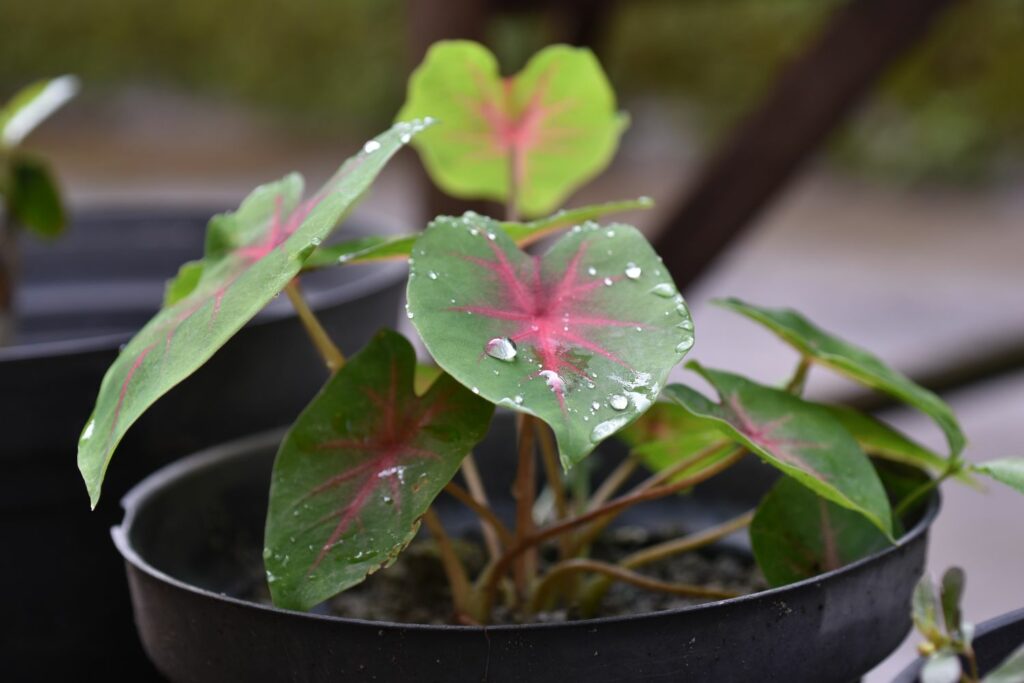
Depending on whether you have chosen a sprouted plant or a tuber, the planting procedure will be different. Grodda Caladium plants are placed in a pot with a drainage layer and high-quality soil and placed in the place described above. On the other hand, if you want to plant one Caladium tuber, proceed as follows:
- Plant your caladium in fresh substrate in March
- Remove old soil from the tuber
- Bathe in lukewarm water for 1-2 hours
- Turn the tuber in the right direction: underneath it is quite flat and smooth, above it more structured with sleeping eyes
- Prepare the pot with drainage holes and drainage layers
- Fill two thirds with soil
- Insert the tuber with the right side up
- Cover with underlay
- To finish, water vigorously
Tip: You can also plant the tuber a little flatter, but upside down. In this way, the petiole becomes shorter and a busier, more compact plant is created.
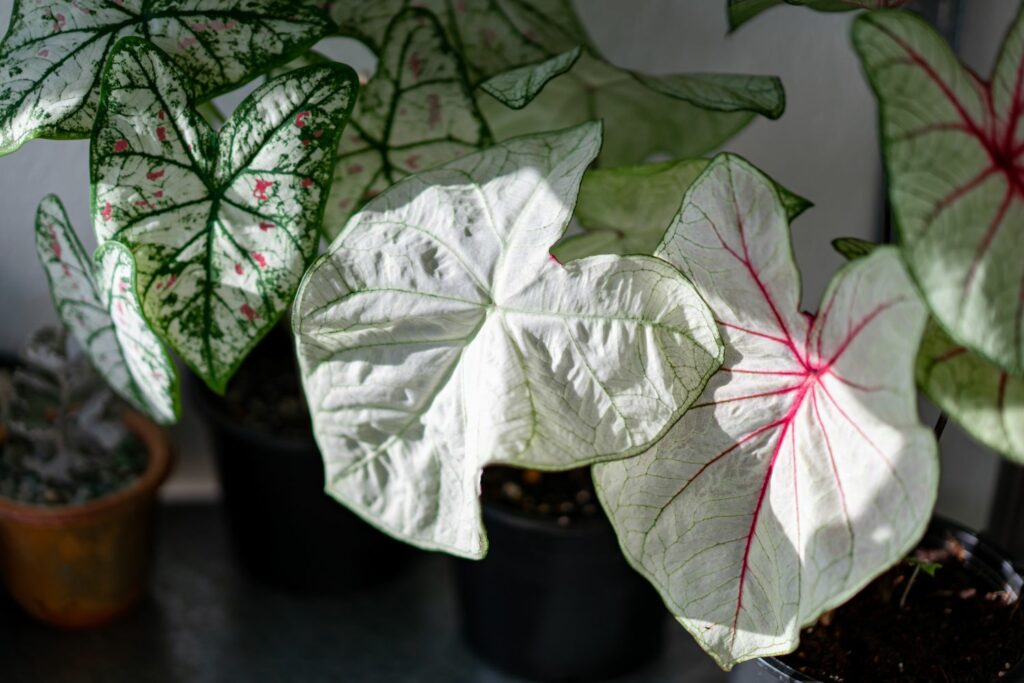
The pot with the tuber is now best placed in a warm place at 25 to 27 ° C and keep the soil well moist. Also stretch plastic wrap or a plastic bag over the pot and air it once a day to prevent mold from growing. Remove the film completely when the first leaves appear. This usually takes 2 to 4 weeks. Then place the plant in a cooler place, at about 21 ° C. After the first shoots have appeared, you can prune the top so that the plant branches better.
Tip: this summer, Caladium can also be placed outdoors in a shady place. Transplantation is also possible, but the plant must be dug up again in the autumn and taken indoors, as usual with dahlias (Dahlia).
Caladium care: the most important measures
The main part of Caladium care is watering. Caladium has moderate to high water requirements, so the substrate should always be kept slightly moist. It is best to water directly into the soil at the bottom and remove the drainage water from the barrel after about 15 minutes. Slightly acidic, lime-free water such as rainwater is ideal.
Tip: Do not water with hard, lime-based tap water, as it may raise the pH of the root zone. Caladium responds to too high pH levels with an inability to absorb magnesium. This results in a lack of nutrients due to the wrong water.
During the growing season, ie between spring and autumn, caladium should be fed with liquid fertilizer every two weeks. A liquid fertilizer for deciduous plants is suitable for this purpose, for example our Plantura Liquid Houseplant Food. It is simply mixed in the irrigation water and applied with a jug. The nutrients are readily available and can be absorbed by the plant. Do not choose nitrogen-rich fertilizers, as this may cause the leaves to turn green.
Towards the end of the growing season, around September or October, Caladium stops growing because only the tuber survives the winter, not the leaves. Initially, only small leaves are formed, before all eventually die and it is time to overwinter the tuber. New leaves then grow out of it in the spring. Caladiums tend to fall victim to root rot in the winter. Therefore, they should be properly wintered as described below.
Why is my motley leaf hanging? If Caladium leaves hanging, it may be due to lack of water. Check that the surface is dry to the touch. In this case, dip the caladium together with the pot in hot water until no more air bubbles appear. After that, let the soil drain well. This ensures a water supply for the time being. Look for more regular watering in the future. Another possible cause is cold drafts. If the caladi is placed in a draughty window, it is best to find it a more sheltered place.
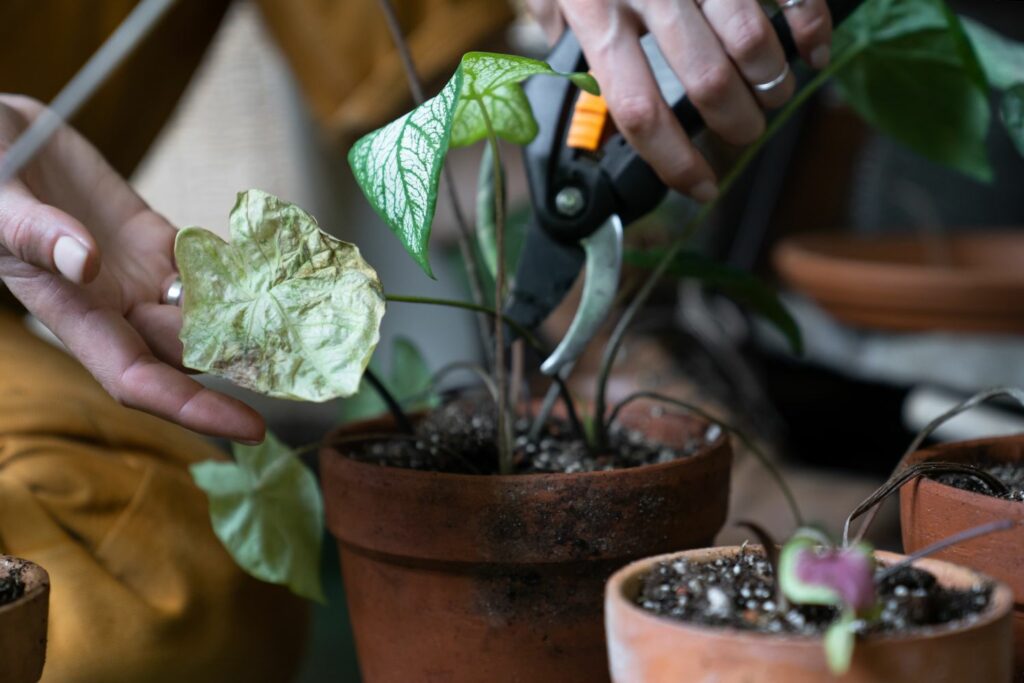
Reproduction
The time in the spring, when the variegated tuber is replanted and allowed to germinate, is used to reproduce Caladium. To do this, when the tuber is large enough, divide it into several small tubers. Each section must have at least one dormant eye, that is, a bud plant. Carefully cut the mother onion apart with a sharp knife. To prevent mold growth at the cut surfaces, cover them with charcoal and allow to dry for one week at room temperature. Then place the tubers in separate pots as described above.
Very strong nodules also form secondary nodules that can be removed when they are large enough.
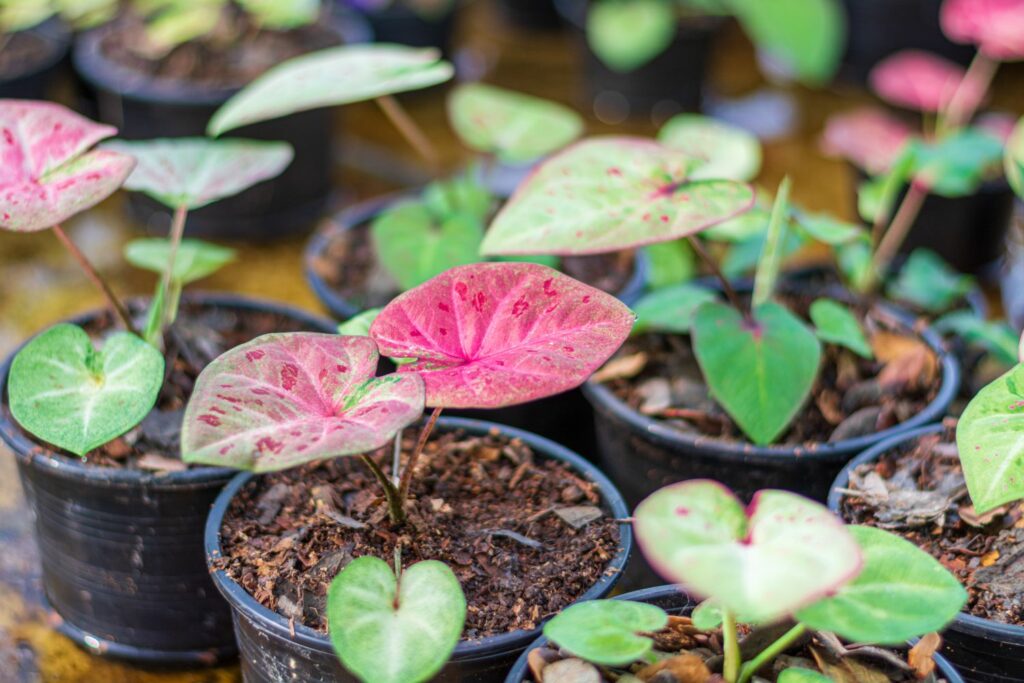
Wintering Caladium
Proper wintering of variegated leaves is crucial to ensure that fresh leaves germinate next spring. However, during wintering Caladium, it is not the whole plant that is critical, but only the tuber. Overwintering the tuber is important to ensure that it continues to live. However, the dormant phase does not occur by itself, but must be actively induced. In the process, the conditions for the natural place are imitated. Winter rest begins around September or October. From this point on, the care of variegated leaves is gradually phased out: fertilization is no longer done and the watering frequency is reduced so that the substrate dries in between. The watering intervals get longer and longer, until any remaining leaves begin to dry up and die. When all the leaves are dry, they can be removed. The soil should now be completely dry. Now the tuber is dug up, thoroughly cleaned, dusted with a little carbon powder and dried for about 2 weeks before it is stored over the winter in a box with substrate such as pure expanded clay or sand. The storage temperature is about 20 ° C. Sometimes the substrate can be sprayed with water to prevent complete drying of the tuber.
Alternatively, the tuber can overwinter in its pot – but this makes the emergence of fungal pathogens on the tuber more likely. It is very important to make sure that the surface is almost completely dry.
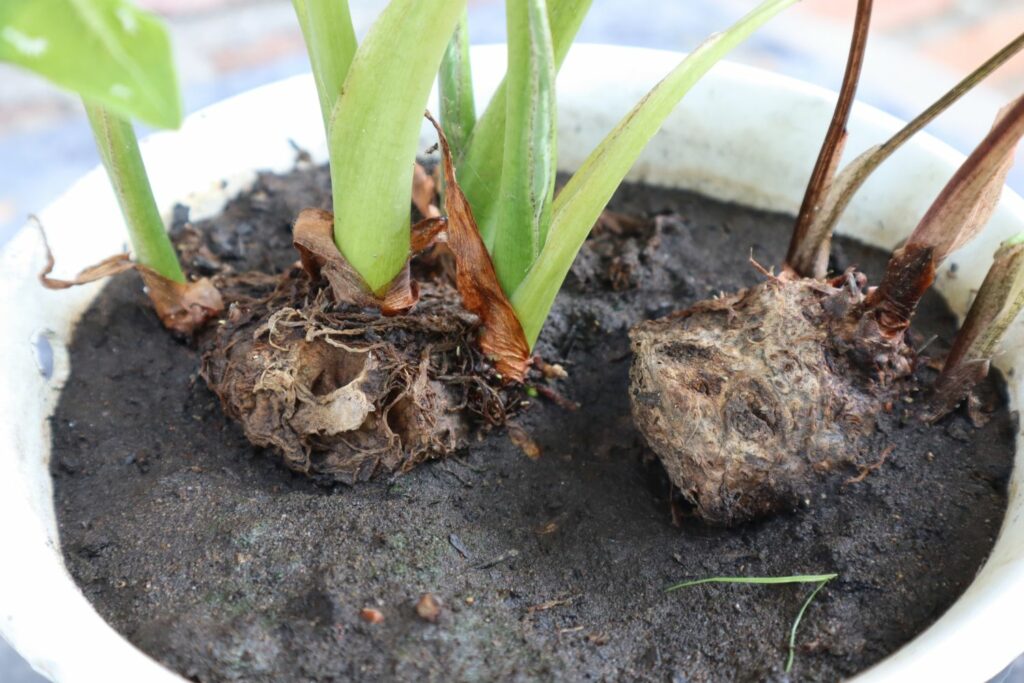
Winters Caladium
After wintering, the tubers are put back in the ground in March. As described above, after two hours of water bath, the tubers are placed in a pot with a drainage layer and soil and then placed at 25 to 27 ° C and high humidity until they germinate.
Is the motley leaf poisonous?
Like many other houseplants in the arum family, the variegated leaf contains calcium oxalate crystals which can cause irritation and swelling if they come in contact with the skin. Ingestion of plant parts also causes diarrhea and vomiting. Caladium is therefore toxic to cats, dogs and other animals, so especially fallen leaves are best discarded quickly.
Those with limited space can alternatively choose the mosaic plant (Fittonia albivenis). Here, too, there are several varieties with variegated leaves, all of which are quite easy to care for, but much smaller than the variegated leaf.





